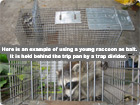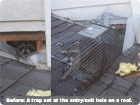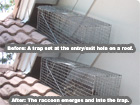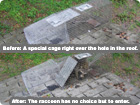The below guide is written by a naturalist and wildlife removal specialist with many years of experience
and hundreds of cases of safe and humane removal of wild animals from homes and buildings. This guide provides the information needed to understand
and solve a problem with raccoons living inside the attic of a home.
NEED LOCAL HELP? We have wildlife removal professionals servicing 95% of the USA. Click here to
hire a local raccoon removal expert in your home town. Updated 2024. But read the below advice first!
So! You have a raccoon (or multiple raccoons) in the attic of your home. Most
people become aware that an animal is living in their attic when they hear scampering, scratching, or walking noises above the ceiling. A wide variety
of animals choose to live in the attics of buildings, from rats and mice, bats and pigeons, squirrels, opossums, and of course raccoons. Most of these
animals will oftentimes use other areas of the home as well, from the soffits to the wall voids to the space between floors, so the attic is not the
only area you'll find critters.
How To Get Rid of Raccoons in the Attic: The main principle is that you've got to first find out if there's a litter of baby raccoons (almost
always yes), then remove the babies and trap the adult female, and then find out how they raccoon(s) got inside the attic, and after they are all out, seal
the entry holes shut. Cleaning up raccoon waste afterward is also a good idea. Below I discuss the details of the process, and it is rarely easy.
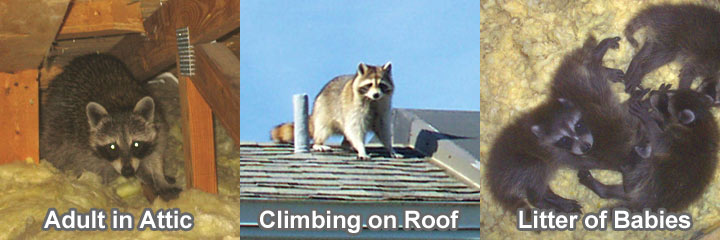
Raccoon Noises: It's often possible to determine the type of animal by the noises alone. Raccoons are the largest of these animals, so the
sound is often "heavy" - more like thumping or walking than the light scurrying of a rat. Additionally, raccoons are primarily nocturnal, so the
noises occur at night. Most of the noise might happen shortly after dusk, when the animal leaves the attic, and again sometime in the night when it returns.
However, the timing of the noise may vary, and sometimes raccoons will stir during the daytime. In addition, raccoons are often vocal, and it's possible
to hear their various growls, chirps, cries, and other noises. If there's a raccoon family, consisting of a female and a litter of baby raccoons, you
will very often hear the very distinct and unique crying and whining of the babies, surefire evidence of raccoon presence.
Raccoon Sightings: Many people with a raccoon in the attic see the animal. It's a large critter, and it doesn't exactly hide its presence
with swift and silent movements, like a rat. Raccoons are also often active in the daytime, especially ones living in an attic (see below), so it's
very common for people with a raccoon in the attic to actually see the animal, as it climbs up the downspout and onto the roof, or sniffs through the
garbage can.
Why Are They There? Wild animals live in attics because it's great habitat. Attics are generally warm, dry, safe, and protected from the elements.
Attics are often in close proximity to the food sources of urbanized animals - garbage cans, pet food, and other human-influenced food sources. An attic
is like a big, hollow tree or cave - it's a great place to live! Additionally, female animals have a strong denning instinct when they are pregnant,
and instinctively seek out safe, enclosed areas. It's very common for a female animal about to bear young to find its way into an attic. In fact, and
I'm probably going to repeat it multiple times here, the most common scenario with raccoons in an attic is that of a female with a litter of young.
The primary reason a raccoon enters an attic in the first place is so that she can give birth to and raise her young pups. Thus, most incidents of raccoons
in attic are in spring, from February - May.
How Did They Get In? Raccoons are excellent climbers, they are very strong, and they have very nimble hands. They have no problem entering
any attic they choose, on almost any home. Most of the time, they've chosen an attic based on convenience or proximity to their normal home range. If
there's an easy and obvious way in, all the better. A house with wide-open holes and easy access stands a higher chance of seeing a raccoon enter at
some point. Easy climbing access, such as trees adjacent to the house, also increases the probability of animal entry and habituation. But even without
nearby trees, raccoons have no problem climbing almost anything. I've seen them climb easy areas on homes, such as downspouts and screened porches,
but also harder areas, such as wood trim, brick walls, or even the smooth corner of houses. They don't really need much to grab on to. They are amazing
climbers, and one of the few animals with the capability of swiveling the hind foot around 180 degrees to descend headfirst. They can enter the attic
in a variety of places. The most popular area is any place where an eave meets up against a roof portion of the house, such as a dormer, or any architectural
bend leading sections of the roof to meet. Home builders do not secure soffits to the roof - they are only interested in keeping water out, and ventilation,
and don't think about animal entry. Other very common entry areas include soffit vents, gable vents, and other roof vents. Sometimes raccoons will simply
rip right through the shingles and wooden roof, right into the attic - they are that strong. Click here for more photos of raccoon entry points.
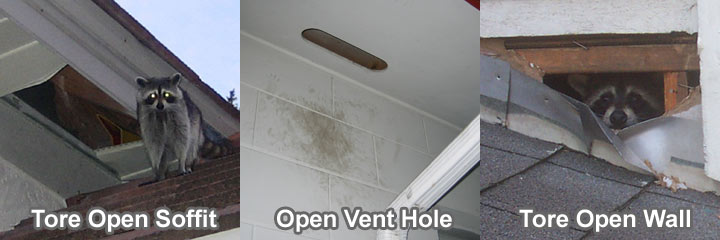
What Do They Do Once Inside? After a raccoon finds a way in and decides to live in an attic, it basically sets up shop. It establishes areas
in the attic it likes to live in, establishes feeding and bathroom areas, it flattens and clears out insulation in areas it wants to sleep, and if it's
a female, it finds areas in which to give birth and raise its young. During the course of its time in an attic, it expands all of these areas and uses
more and more space.
What Damage Does a Raccoon Cause in An Attic? The raccoon often finds bedding material by shredding roof or wall paper, and shredding vent
ducts and insulation around pipes. I've seen them destroy all the ducts in an attic, and even tear apart cooling systems, vents and fans, and even wood
beams. Sometimes it may simply destroy things for unknown reasons, just like people do. Raccoons are large animals, and I've dealt with many cases of
raccoons falling through the ceiling and into the home over the years - not a pleasant situation! They also scratch and chew, and I've seen several
cases in which they've clawed and chewed electrical wires. I have many photos of raccoon damage if you click here. Animals that live in houses also sometimes die in houses, and the odor of a dead raccoon
is incredible. In one case, a raccoon tore up all the AC ducts in the attic, then crawled down into the air handler and got electrocuted and
died. Click here for photos. The smell was tremendous. If they live in an attic for any length of time, they walk all over and flatten the insulation, lowering the R-Value
(insulating effectiveness). They also urinate and defecate everywhere. I've seen some attics that have been heavily contaminated with raccoon droppings.
This is not only unsanitary and smells bad, but raccoon droppings are host to a number of zoonotic diseases, including raccoon roundworm.

What Health Risks Do Raccoons Pose? Rabies is the most commonly cited disease associated with raccoons. Never approach a raccoon that looks
sick, confused, or that is moving awkwardly. Distemper is also an important raccoon disease, the early stages of which mimic rabies, and it's important that
domestic dogs and cats have full vaccinations and are checked for worms once a year. As stated above, the droppings of raccoons can contain raccoon roundworm (Baylisascaris procyonis & B.
columnaris). This parasitic worm can and does infect humans and is very dangerous. The egg spores in the raccoon droppings are light and can become airborne, and people can
breathe them in and become infected. Infection of humans can lead to larval parasite migration to the central nervous system. These egg spores can live
for years as dry pods. Raccoons also carry Giardia lamblia, a protozoan causing diarrhea associated with ingesting food or water contaminated by raccoon
excrement. Trypanosoma cruzi is associated with raccoon excrement as are Rickettsia rickettsii, Leptospirosis, and Salmonella. They are also host to
a number of parasites, such as lice and fleas. Oftentimes people with raccoons in the attic will notice that their pets (and in a few cases themselves)
suddenly have fleas that they never had before. I often get fleas on me when I enter attics that hold raccoons and I treat raccoon diseases
seriously.
Why Would I Want To Remove Them? People who have raccoons in the attic often first object to the noise they hear, which
keeps them awake at night. That's enough for most people. Some people simply don't like the idea of having wild critters in the attic. However, the
main problems are that if the raccoon lives in the attic for enough time, it almost always starts to cause damage - to the drywall, to the ducts, to
the vents, to various new areas outside the home. Raccoons are inquisitive animals, they are actually extremely messy, and they just plain destroy things
by their nature. They are messy with food or debris they bring in, but much moreso, with their waste. Some raccoons are actually neat about it, and
repeatedly use the same area as a latrine. More often, the waste is scattered prolifically throughout the attic. The insulation is usually compromised,
often severely. For these reasons it's good idea
to get rid of raccoons in the attic. In fact, raccoons are one of the few animals for which homeowner's insurance will pay for attic restoration and repairs.
Your local pro may be able to give you free advice about how to handle and clean raccoon droppings and bill to insurance.
Click
here for more photos about attic contamination and restoration. Insurance
companies won't cover rodents, such as rats or squirrels. It is up to you, and not all raccoons behave the same way, but aside from just the noise,
the risks of damage and spread of disease make the removal of the raccoon(s) a good idea. You can also try raccoon prevention techniques
instead of strict removal, but in many cases, getting them out of the area completely is the only way to go.
What About Raccoons in a Chimney? Raccoons get into chimneys as well. Some of the same principles as outlined below apply to raccoons in chimneys.
However, odor deterrents are more effective due to the concentrated area. DO NOT START A FIRE if you have raccoons in the chimney - you'd have to open
the damper to let the smoke out, and they will enter the fireplace instead of climbing out. Even if they don't get into the your house or fireplace,
you will cook animals alive and get a horrendous odor that will last a long time. Many professional wildlife removal experts have special raccoon in
chimney removal systems if odor deterrents don't work. Click for more info on raccoons in the chimney.
Won't They Just Leave on Their Own? It depends on the situation of course, but the answer is generally no. Are you going to just leave your
house in a few days for no good reason? If it's a female raccoon with young, she will first breast feed them for about ten weeks, then start to take
them on forays outside. She will remain with them for nine months, showing them where to find food and things like that. Raccoons are great moms. They
will bring the whole brood back to the attic before sunrise. After they are nine months old, the young will set off on their own. At this point, its
possible that the mother raccoon will abandon the attic. However, it, or one of its young, might decide to stay. And when the raccoon becomes pregnant
again and has a new litter after the 2-month gestation, it wants to go back in the same attic again. Raccoons are creatures of habit.
How Do I Get The Raccoons Out of My Attic? I will now discuss the various methods used to remove raccoons from attics, outlining their various
degrees of effectiveness and the level of expertise needed to successfully achieve permanent removal. Remember, it is my goal to be as humane as possible
to these remarkable and cute creatures.
Do Repellents Work? In some cases, yes. This is the first and easiest thing that you can try. Especially when a female raccoon is concerned about
having a safe place to raise her young, a harassing presence including any scent (predator urine is good, as is raccoon eviction fluid discussed below)
and noise (radio) might encourage her to leave the attic with her young. One wildlife rehabber gave me this advice: "A bright,
noisy attic is not a comfort zone.
Flood the attic with light AND add a radio playing as loud as you can before the neighbors complain will remove two of the three reasons why mom animal chose the
spot. No longer feeling comfortable, she will relocate her babies to a safer environment. If this does not work (may take 3 or 4 days, mom has to find another spot
before she removes them) then call a professional." That said, in general there are many long-standing old wives' tales about animal
and raccoon repellent, and there are many modern products sold meant to evict unwanted critters from property and homes, and most all of them are bogus. Some of
the old-fashioned standards include naphthalene (moth balls), ammonia, bleach, and even human hair. The idea behind these repellents is that they simply
create an unpleasant odor that raccoons don't like, which encourages them to leave. In my years of experience as a wildlife removal professional, I've
seen many of these tactics used in an attempt to evict raccoons. I've never seen them work, but that's also perhaps because in the cases they do, I'm not called
out. The problem is that an attic is large and well-ventilated, and the odor isn't very strong. A raccoon will often just move to another, less offensive
part of the attic. Even in cases in which the odor is strong, it's not enough incentive to make the animal leave. Once a raccoon has established a home
in an attic, it takes more than a bad odor to make it leave - you wouldn't abandon your home if someone spread some mothballs inside. This is a wild
animal that needs to survive, and it will tolerate quite a bit in order to keep its home. That includes all of the current repellent and deterrent products
sold. If you want to keep raccoons away, it's very hard, and only a few very aggressive tactics might work. Read about what are raccoons scared of. But these tactics aren't
long-term solutions, and neither are products. If you do an online search, you will find all sorts of raccoon repellents sold, many with confident money-back guarantees. Most of them are made
of ...mothballs. In fact, most animal repellents sold are made from either mothballs or coyote urine. I've been to many homes at which the homeowner has
placed a great deal of mothballs in the attic - one had fifty pounds of mothballs! - and the raccoons didn't care. They also don't respond to coyote
urine. Some people recommend the use of bright lights, strobing lights, or noises. The most common noise deterrents are regular radios and ultrasonic
high-pitch sound emitting devices. Once again, I've seen both of these tactics used multiple times to no effect. In fact, the FTC has issued an official
warning against the high-pitch noise machines, stating that they are 100% ineffective and fraudulent. It'd be nice if a simple product would solve the
problem. That goes for almost any cheap and easy fix for a serious problem. The truth is that repellents rarely work. Go ahead and try every one of
them if you're not convinced, and then take care of the problem properly when you discover that cheap repellents are pointless. This site about
how to get rid of raccoons discusses the matter of raccoon removal
and the often ineffectiveness of repellents more.
Does Poison Work? There is no registered poison for raccoons. There is no legal poison for raccoons. There's no effective poison that I know
of for raccoons, though I admit that I don't know much about poisoning animals. That's because I consider poison the worst possible approach to animal
control. It's ineffective and inhumane. If you were able to successfully poison a raccoon, it would most likely die in the attic, where it would decompose
for months, and create a horrible odor throughout the house. It has to be smelled to be believed. Furthermore, the death of the animal would be very
painful and inhumane. Finally, if it's a female raccoon with babies, the mother will die, and the babies will be orphaned in the attic, where they will
suffer and starve to death, and then die and cause more odor. And poison won't solve the root of the problem, as I'll discuss below. Please don't try
to poison a raccoon or any other animal. I know that people want to try this method, because they ask me, and because I see many internet searches for
the phrase raccoon poison. Please, read on, and learn how to handle the raccoon problem without attempting to resort to poison.
Click below photos for more examples of trap sets by professionals:
Do Traps Work? Yes. But it has to be the right type of trap, and it has to be used in the right way. There are dozens of types of raccoon traps, some live traps, some lethal traps. I'll quickly discuss the various types of traps, but before I do, I must point out the single most important thing to keep in mind regarding raccoons in the attic, and the reason a raccoon in the attic is not such a simple matter.THE MAJORITY OF THE TIME, A RACCOON IN AN ATTIC IS A FEMALE WITH YOUNG - Yes, the majority of the time, about 80% of cases of any raccoon in an attic, there's a litter of 3-5 baby raccoon pups. The most common reason for a raccoon to enter an attic and choose to live there is the case of a female who needs a safe place to give birth and raise its babies. The mother raccoon usually gives birth shortly after moving into the attic, within 1-2 weeks, and then spends about 10 weeks nursing the baby raccoons. She is very active during this time, often leaving the attic during the daytime to gather additional food. Then at 10 weeks, she starts to take the young out at night to forage. The presence of these young complicates the matter of removing raccoons, because if you trap and remove the adult female, the young are left behind. I've seen several dozen such cases: a homeowner uses some sort of trap to remove the mom, and then the homeowner starts to hear the scratching and squealing of the starving young, and they call me. Or they hired a lazy and ignorant wildlife trapper who trapped the mom raccoon, charged their fee, and left, and now the babies are left behind and they don't want to have to come back to finish the job. That's when I get called out to take care of the raccoon problem. This happens almost once a week for me. It's a big problem. I see too many cases of mother raccoon removal, and then orphaned and suffering babies. If you don't remove the babies, they squeal and suffer as they starve for two weeks, then die, rot, and cause a big odor. When I get called out to such homes, I crawl through the attic and find the babies, remove them by hand, put them in a sack, and remove them from the attic. I then bring them to a wildlife rehabber who will feed and raise them and relocate them to the wild when they are large enough to fend for themselves. If the problem had been taken care of properly in the first place, the young would be able to stay with the mother during relocation, where they would stand the best chance of survival and being raised properly. Thus, the presence of baby raccoons makes simple trapping a not-so-simple matter. The babies, as they lay in a cluster in an attic, aren't capable of entering traps. Thus, the use of traps by amateurs or ignorant trapping companies often creates a bigger problem than before! If you do trap a raccoon, check for nipples! If you can see them, you've got babies up there, and they've got to be found and removed, and it's often no easy task.
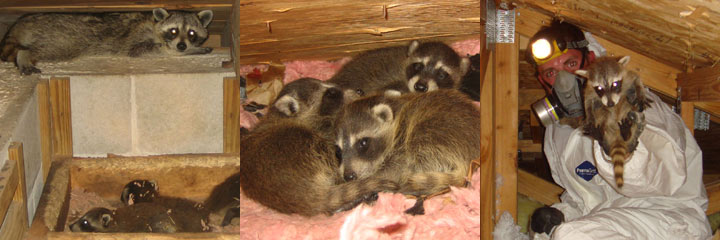
Types of Traps - Here's an analysis of types of raccoon traps and raccoon trapping techniques:
Body Grip Traps - These are lethal traps, kind of like giant rat traps. There are several types, with the most common the double spring-loaded connibear traps. These types of traps are used mostly by olde-time fur trappers. The basic gist is that they are set over an area a raccoon will move, such as over a hole leading into an attic, and when sprung, snap down on the animal and kill it via choking or crushing. They are dangerous and difficult to use, and very few people, other than old fur trappers, would use them. If you hire a wildlife trapper who uses this type of trap, please be aware that there are better alternatives. I've written about various ways of how to kill raccoons.
Paw Hold Traps: These types of traps are also only really used by trappers, often fur trappers, some of whom perform nuisance wildlife removal services. There are several different types of paw hold traps. These traps work by clamping down on an animal's paw and holding it. It's basically a small snapping clamp device staked down in some fashion. When the trapper catches a raccoon with this type of trap, he usually then kills it via shooting. Again, there are better trapping alternatives.
Live Cage Trap: This is by far the most common type of trap used by wildlife control companies and do-it-yourself homeowners. There are many different makes and models of cage trap. Cage traps are generally large metal cages into which the raccoon enters, lured in by food. Near the back of the cage is a trip pan. When the raccoon steps on the pan, it triggers the trap door shut, and the animal is trapped inside, alive. Some of these traps are made from different materials, such as solid-walled plastic or other materials. Most are made from steel bars. A cage trap needs to be large enough to hold the raccoon, and most raccoon-size cage traps are at least 32 inches long and 12 inches high and wide. If it's too small, the animal won't fit inside, or may trigger the trip pan, but not allow clearance for the door to shut all the way. The most commonly sold brand in the United States is the Havahart brand, which is sometimes sold in large hardware stores. The fact that it's readily sold to the public often leads people to believe that they can just go out and trap animals. However, there are many very important considerations when raccoon trapping that one should consider before just buying a trap and setting it.
1) How To Target The Correct Animal? One problem amateurs encounter is that they set a trap and catch every other animal in the neighborhood, instead of the animal that is causing the problem. I've been to many homes in which homeowners have set their own traps and rattled off lists like, "I've caught two skunks, an opossum, and a stray cat, but I can't get that darn raccoon!". This is a problem because these unintentional catches can be harmful to the animals - it's always stressful to get caught, if not lethal, even with "humane" traps (see below). In addition, I've seen several cases in which homeowners have caught neighborhood pet cats. One of these incidents resulted in a lawsuit when a pet cat died from exhaustion/dehydration from being carelessly left in a cage trap for two days. An expert wildlife removal professional will know how to target the animal properly. I never set cage traps outside on the ground if there's a raccoon in the attic (see point 6) This may catch the right raccoon, but there's a good chance that it won't, and will cause other problems.
2) What if I Can't Catch it at All? Failure to catch the animal commonly arises amongst people who don't know much about trapping. So many important and subtle nuances go into successful trapping. Even with this advice, the chance of failure or accident is higher than not. I really don't believe that uneducated people should attempt to interact with wildlife. You will probably be better off calling a professional trapper or a wildlife rehabber who can help you do it right and legall. The right type of trap must be set (at least 32 inches long). It must have no defects. It must have the correct pan tension. It must be flush to the ground with no wobble. It must be set in the animal's path of travel or exploration. It must be in area free of things the animal can damage. It should be in a shady spot. The right number of traps should be set for the situation. Special techniques must be used if the animal is trap-shy. And so on and so on.
3) What Type of Bait Should I Use? This factor isn't nearly as important as other factors in terms of success. Everyone thinks that bait is such a big deal. I've been to dozens of houses using all kinds of raccoon bait, and it didn't matter, the correct animals were not caught, due to other reasons than just bait. Raccoons are omnivores and will eat almost anything. That said if you must do it yourself, you should not use meat-based baits, which are more likely to attract opossums, skunks, and of course, cats. Better baits include white bread or marshmallows. A trail of bait should lead from out of the trap into the trap to acclimate the animal to eating the bait and lure it in for more. Most of the bait should be set in the very back of the trap behind the trip pan. But in the case of raccoons in the attic, you should not be trapping with bait at all (see point 6)
4) What Types Of Accidents Can Occur With Trapping? I've seen it all. From the above mentioned case of killing a pet cat, to several cases of killing innocent wild animals. Many people simply set the trap in a convenient or random spot. But what if that spot is exposed to the sun, and you leave the animal out all day I direct sunlight - it might die of dehydration or heat stroke, which I've heard has happened. I've seen cases in which a trap was set next to a swimming pool, and the raccoon pulled itself in and drowned, and I was called to fish it out of the water and cremate it. I've seen cases in which raccoons have reached through the bars of the cage and ripped up screened doors and pool enclosures, pulled up electrical wires, and more. An astute trapper keeps his eyes open for all of these dangers and sets the traps properly and secure in a safe place. In fact, when I do trap, it's often with cages bolted to the roof, in order to get the target animal. But once again, regular trapping is not the answer with raccoons living in the attic (see point 6).
5) Is it Legal for me to Trap the Raccoon? In most states, no. Or, if it is legal, you must kill and dispose of the animal on your property at the time of capture. Are you able and willing to do so? It is not legal, in almost all states, to trap a raccoon, stick it in the trunk of your car, drive it off to the woods, and release it. Many states require immediate dispatch or immediate release at the capture site - kind of defeats the point of trapping. Some states don't allow for the relocation of rabies vector species. Check the regulations posted by your state's department of wildlife (or fish & game) and you will see that it is illegal to do so if you are not a licensed wildlife control professional.
6) Okay then, I Want to Avoid the Law and do it Myself - How? Okay, here's the deal if you want to know how to get rid of raccoons in the attic yourself. As stated, the vast majority of the time, the raccoon in the attic is a mother with babies. You don't trap the mother and leave the babies up there to cry for two weeks, die, and cause a big odor. First, you go into the attic and find the babies! That's right, you explore the whole attic and remove the young by hand. Be careful, there's a protective and ferocious mother raccoon nearby! Actually, I've removed hundreds of raccoon litters in my lifetime, and I've never been attacked. But there have been some close calls, so do so at your own risk. It might be a good idea to wait until the mother isn't nearby the litter before removing them. Of course, when in an attic, be mindful to walk only on the wooden beams, or you'll fall through the ceiling. And be careful not to get insulation on your skin. I wear a HEPA filter mask to avoid breathing in airborne dust particles. And I wear thick gloves, particularly when handling wildlife, even baby raccoons, which are usually gentle, but can bite and claw. I put them in a pillowcase, and bring them out of the attic. They can often be very hard to find. The mother raccoon stashes them in a safe place, often down at the very tight edge of the attic, down in the soffit, or down a wall. I usually find myself climbing through very tight quarters to find the young. It can be hard to do, but a 75-year-old woman I know, a wildlife rehabber, has done it, so I guess it's possible for anyone! I bring the young outside, and then - here's one of the tricks to solving a problem with raccoons in the attic - I use the babies as "live bait" to trap the mom! There are usually four babies, so I set two traps (one is backup) with two babies in the back of each trap. They are held back there by a metal cage divider. A mother raccoon is very protective of its young, and will do anything for them, so it will always enter a trap to get to its young, even if it is smart and "cage shy". I set the trap against at least one wall and put a heavy divider, such as a concrete block or wooden plank on the other side so that the mother does not try to reach through the trap from the outside first and trigger it. This happened once in my life, and the poor mother dug a rut about four feet deep in its struggle to get inside the cage. Also, there's a chance that the mother raccoon will injure her babies if she can reach in to them easily. I want the mother to go into the trap. Once she's trapped inside, she usually bends the divider bars easily and she's reunited with her young. When I retrieve her, I slide out the metal divider. So there you go, I never use bait. I always target the exact raccoon I want, the mother, and I remove both her and all of her young, so they are all out. If I were ever to trap a raccoon with visible nipples, I'd be sure to go find the young, and if I could not, I would release the raccoon on the spot, so as not to leave orphaned young. There are other ways to remove them all without using the "babies as bait" method. One good method is to mount a trap onto the entry hole into the attic before entering the attic. Then when you enter the attic, you scare the mother raccoon out with your presence (make noise or chase it with a snare pole) and it will run out of the attic, out its hole, and right into the trap! Or, if the mother raccoon stands its ground in the attic, you can physically capture it with a professional snare pole. A thrashing, angry, strong raccoon on the end of a snare pole is not a tactic for the faint at heart. It should be immediately transferred to a holding container, such as a solid-wall box trap, which you should bring into the attic upon entry, along with the snare pole, thick gloves, mask, pillow case, head lamp, etc. Remember, if you get the raccoon by either of these methods, you still have to find and remove those young.
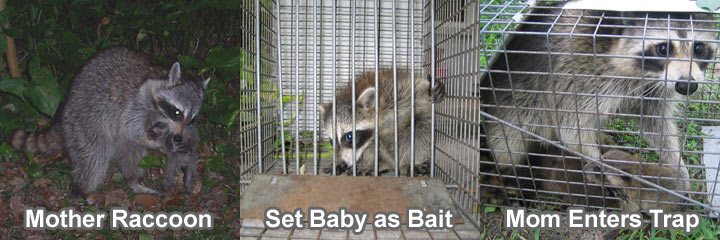
What if I Can't Find the Litter of Baby Raccoon Pups? The baby raccoon nest can be very hard to find at times. The only answer is to keep trying. I often sit, very still, in the attic for a while, listening carefully. Eventually, one of the young will chatter, even just a little, and then you can track them down. I always ask the homeowner if they hear the chattering noise, and if so, where they hear it. If the raccoons are down a wall and I know the approximate area, I put my ear to the wall and listen. If that doesn't work, or to pin down the exact spot, I carefully run my hand over the wall or ceiling, and when I feel a warm spot, I know that's where the litter of young are nesting! I cut a hole in the drywall adjacent to the area, and remove the young, and then patch up the hole. Persistence is the key to success.
What Do I Do with the Raccoon Once I've Caught It? First of all, check the trap every day, or several times a day, so that you don't leave an animal suffering in a cage for long. When handling the trap, be careful, because raccoons can reach far outside the trap bars and scratch. And don't let your fingers enter the cage, or the raccoon will lunge and bite! Pick up and move the cage with care. Some states require that the animal be euthanized, often under laws regarding the spread of an animal that could possibly carry rabies. Many people and wildlife removal companies ignore such laws, because they don't want to kill wildlife, just like many people ignore wildlife regulations out of ignorance or lack of concern for laws. If you do relocate the raccoon, it should be at least five miles from the capture site. Some people recommend at least ten miles. Many critters are amazingly adept at tracking their way back to a home range. If you relocate a mother raccoon with babies, the mother will bolt from the trap and run away as soon as it's opened. Let the babies go as well (put them in a box with heat), even if they are very young, and the mother raccoon will always come back for them and bring them to a new shelter. For additional information on this tactic from a professional rehabber, including the risks, click on relocating raccoons. Bear in mind, this time period may be tough for her and her young, but the young stand the best chance of survival with their mother, even over a licensed wildlife rehabber. If you do find yourself with orphaned baby wildlife you can do an internet search for a local wildlife rehabber. The site wildliferehabber.org is an example of a site with a searchable directory.
Is my Job Done Once The Animals Are Out? Ha ha, of course not. There remain three important things to do. The first is to fix the holes that the raccoon used to get into the attic in the first place. If you leave the holes open, you're going to get new wildlife entering your attic eventually, and you have to start out all over again. Repair shut any open areas, and secure any vulnerable areas. Bolt in new heavy-duty steel screen over your vents. Bolt down your torn open soffits and seal them shut with concrete screws and sealant. Fix the hole in the roof, etc. Second, you'll want to inspect the attic and repair any damage in the attic, from torn ducts to cleared insulation. I've been to plenty of homes at which homeowners have been wasting all their AC air, blowing it into the attic through torn ducts! I've also seen cases of electrical shortages from chewing on wires, and water damage from leaks caused in re-plumbing pipes that have been torn open in attics. Often its this type of damage that caused a homeowner to call me out to remove the raccoons in the first place. Finally, you should probably clean and decontaminate the attic to remove any parasites and pathogens that the raccoon has left behind. I remove all of the raccoon poop by hand (with decon suit, mask, and gloves of course), remove all of the urine crusted insulation, and fog the attic with a special enzyme-based decontaminating agent. The above repairs and cleanup are often covered by homeowner's insurance.
This Sounds Difficult: I know that the above process I've described sounds very difficult. It is. There's a reason for wildlife removal professionals, whose level of expertise and knowledge is just as relevant as that of many other professions, such as electricians or plumbers. If you are the type to re-wire your house or fix the broken pipe, then you may think you can trap wild animals. But without the proper tools, training, and experience, you probably will not do the job correctly. In fact, a great proportion of licensed wildlife trappers don't even do the job properly. This is highly specialized work that requires lots of experience and careful attention to detail, and common sense! There are so many variables that go into each situation. The raccoons babies could be down in a wall. They could be more than ten weeks old, and too mobile to remove by hand. Before you hire any unknowledgable exterminator or pest control company to handle a problem with raccoons in the attic, seek out a real wildlife specialist company, ask them to describe their process. If it sounds as though they just want to set a trap on the ground and quickly get to the next customer, find someone else. You want someone who will crawl through the attic relentlessly to find the baby raccoons. I have reviewed most of the companies on this wildlife removal directory and believe most are humane and competent. I've also done a lot of research and found competent and humane wildlife experts in these cities, who know how to get rid of raccoons the right way: Charlotte - Fort Lauderdale - Miami - Seattle - Portland - Oakland - Los Angeles - San Diego - Phoenix - Dallas - Houston - Austin, TX - Arlington, VA - Denver - Cincinnati - Baltimore - Nassau County - Jacksonville - Orlando - Tampa - Boca Raton - Virginia Beach - Chicago, but the directory lists almost 500 US cities and towns.
Are There Any Alternatives? Yes. You can risk attic damage and wait for the raccoons to grow to at least three months old, then set multiple traps outside to catch them all. This allows you to get the young without removing them by hand from the attic. Remember, even at that age, they are vulnerable, and if not kept with mama raccoon, may die on their own. You could also wait for them all to leave at night and then seal shut the openings so that they can't get back in. But just remember, a raccoon that wants back in will be able to get back in - it will tear its way through anything to get back inside. And if you block out just the mother and there are babies still inside, forget about it. She will rip open a new area in seconds to get back inside. There's also a special trick that many trappers are able to use - the use of raccoon eviction fluid. Female raccoons are very protective of their young. They know that if a male finds any baby raccoons, it will kill them, so that the female goes back into heat and can be mated with. Many mammals engage in this behavior. Thus, the scent of a male raccoon, from urine and glands, if spread throughout the attic, will often encourage the female raccoon to move out on its own, and bring its babies with it. It may take a day or two for it to find a new place and transport all the young, but this is another way to get them all out safely. Raccoon eviction fluid isn't generally available to the public, and it doesn't always work, but it's definitely a great tool for experts to use.
The Bottom Line is that a raccoon in the attic is a serious problem, and it's often not the kind of thing that can be solved with a quick and easy fix. I wrote this guide to make homeowners aware of this, so that they can address the problem in the correct manner. Most of all, I've spent my career as a nuisance wildlife specialist confronting the problem of orphaned raccoons in an attic - so many times. It's usually due to inferior trapping companies and do-it-yourself homeowners who trap mama, relocate her, and leave the young up in the attic. Then I get called out because I am capable of finding the young and doing whatever it takes - tight crawls through hot attics, cutting through walls, hours of searching - in order to find and remove them. I think that the issue of abandoned baby animals is a big problem in wildlife trapping, one that many people overlook - until they hear the noise or smell the odor that is. So please, if you have raccoons in the attic, do address the problem, but do it correctly. If you aren't capable of following the above steps, please hire a competent wildlife expert who can do so properly, and ask them the right questions, such as: 1. Do you look for babies? 2. What type of trap do you use? 3. Do you ever use use poison? 4. What do you do with the animals after they are trapped? 5. Do you seal entry points to prevent re-entry? 6. Do you clean and decontaminate raccoon waste?
Topic of the Month: Do raccoons use tools?
It is one thing when some of your regular home visitors, in this case raccoons, come over during the night and make away with food in the garden. It is a totally different thing altogether when they use their famed-break-in skills to access food from the pest feeders or even kitchens that have not been properly secured. Of all the most important distinguishing characteristics associated with raccoons – they best excel at the use of intelligence and high curiosity, their ability to tactfully employ their fore paws for different tasks as well as their increased sensitivity in the palms when it comes to detecting materials they are holding with them.

Raccoons are indicated to be an intelligent breed, but this goes far when they deploy their tool-manipulating skills in combination with their intelligence. Raccoons are highly credited for their highly sensitive forepaws – coming in with long, tapered fingers with a large number of senses in them, which allows them to collect information about the kind of thing they are in possession off because they can make further decisions on how best to use it. Their fore limbs have long fingers coupled with long nails.
However, raccoons lack an opposable thumb, but their redundant thumb is as well highly specialized that it can touch the centre of the palm. Raccoons, due to their lack of an opposable thumb, do not have the ability to manipulate tools in a complex and agile manner like other primates, but they have shown a remarkable skill in using both hands to hold and use objects for different purposes. Raccoons shown a remarkable skill when they deploy both of their and in acute manipulation of tools, which have earned them the coveted skill of break in to homes to steal foods, sneaking into cages to lift bags of food and even turning on the tap to have a drink after they have eaten to their fill.
One question that may still linger round is how the raccoons managed to develop this incredibly strong tactical forepaws. The answer is simple, raccoons were initially native to mixed forests where they lived along river banks, searching for their food under water and pulling out worms and other animals immersed in mud and silt. Over time and as they continuously used these paws, they were specially adapted to the act of getting them out, and that is how they managed to get superior fore-paws. Their hunting under water required that they have a good sensory ability to feel what qualified as food and what failed to qualify as food even before pulling it to the surface, and this is how they got to develop a large number of cells in the pals.
Read more about Do raccoons use tools?.
.
Click here to read my poem about my special Coonskin Cap! Wildlife Education - Information, Advice, and Techniques for the Safe Removal of Raccoons from Attics. Good luck!
